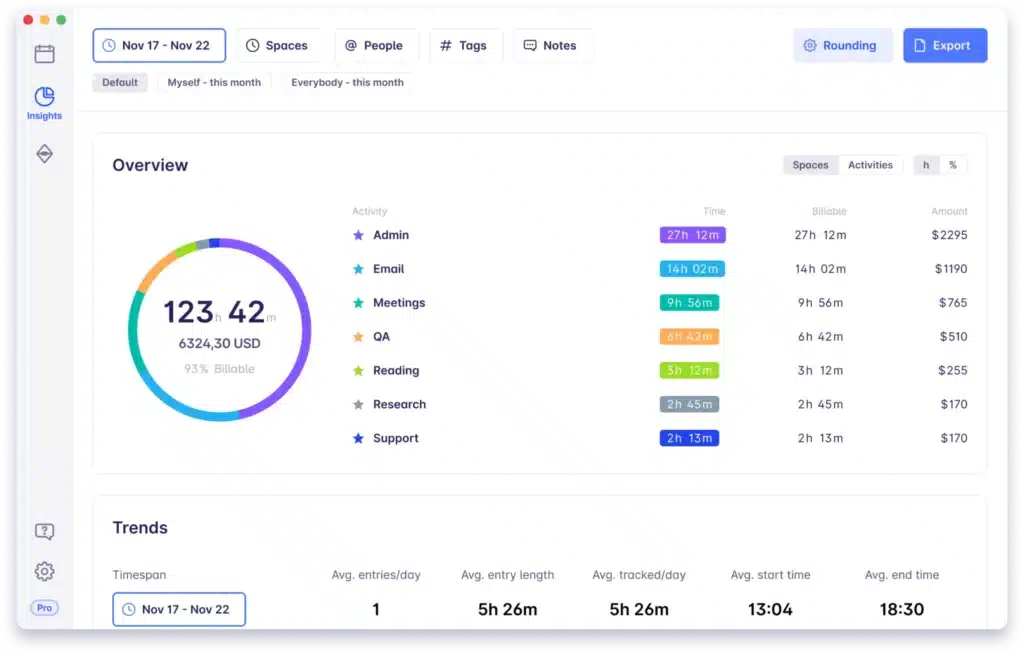Boosting Marketing Agency Profit Margins [Guide]
In today’s competitive landscape, boosting marketing agency profit margins is essential for long-term success and sustainability. As agencies navigate the challenges of delivering exceptional results while managing costs, understanding effective strategies to increase profit margins becomes paramount.

Start tracking billable hours accurately to maximize your agency’s profits
Track in real-time and include the smallest tasks to confidently bill more time
In this article, you will learn about key tactics, insights, and best practices that can empower marketing agencies to optimize their operations and elevate their profitability, ultimately paving the way for continued growth and success.
Whether you run a traditional or digital marketing agency, this article will teach you the fundamentals of boosting your marketing agency’s profit margins.
Additionally, we will explore how time-tracking can effectively increase your agency’s profits.
What is a marketing agency’s profit margin?
Agency profit margin refers to the percentage of revenue after deducting all the costs associated with running a marketing agency.
It’s a crucial financial metric that directly impacts the overall profitability and sustainability of the business. It measures how efficiently an agency can generate profits from its operations.
The agency’s profit margin reflects the effectiveness of the agency in managing its costs, pricing its services, and generating profits.

Learn how a marketing agency 22GRAD increased the ROI of their projects
“The precise reports give our customers a detailed overview about our services, which is key to get their approval and long-term trust.” – Felix, owner of 22GRAD
A higher profit margin indicates that the agency is generating a more significant profit relative to its revenue, which is generally seen as a positive indicator of financial performance.
On the other hand, a lower profit margin suggests that a significant portion of the agency’s revenue is allocated to covering expenses, resulting in lower profitability.
Profit and revenue
Master these concepts and find out how important they are to a company’s success.
What is the average profit margin for digital agencies?
While profit margins can vary depending on agency size, location, and specialization, having benchmarks for comparison is helpful.
According to recent industry data, the best-performing digital marketing agencies can achieve a remarkable 50-60% delivery margin, while start-ups or underperforming agencies fall within the range of 20-30%.
Surprisingly, even those with lower profit margins tend to enjoy healthier returns on investment compared to numerous other industries across the globe.
However, it’s important to note that these figures can vary significantly, and it’s best to focus on improving your agency’s profit margin rather than solely aiming to meet industry averages.

The importance of a healthy profit margin
A healthy profit margin is essential for the success and sustainability of any business.
Next, we’ll highlight several reasons why maintaining a healthy profit margin is crucial.
Financial stability
The first reason is the most obvious — without profit, there is no business!
A healthy profit margin ensures that a business has sufficient funds to cover operating expenses, invest in growth initiatives, and withstand unforeseen financial challenges.
It protects against economic downturns, market fluctuations, and unexpected expenses, fostering financial stability and resilience.
Growth improvement
Profit margins serve as a source of internal funding for businesses.
A healthy profit margin allows companies to reinvest in research and development, acquire new technologies, expand their product or service offerings, enter new markets, and pursue strategic opportunities.
It fuels growth and allows businesses to stay competitive and seize market opportunities.

Unlock revenue growth: Track billable hours with precision
Timeular’s easy and smart experience, paired with its powerful reporting functionality, makes billing time a delight
Sustainability and longevity
A healthy profit margin is essential for a business’s long-term sustainability and survival.
Without a healthy profit margin, a company may struggle to:
- meet its financial obligations
- attract investors
- retain talented employees
- adapt to evolving market conditions.
A sustainable profit margin is a foundation for a business to thrive and endure over the long term.

Business value and confidence
A substantial profit margin enhances the overall value of a business.
It signals to investors, shareholders, and potential buyers that the company is financially sound, well-managed, and capable of generating returns on investment.
A healthy profit margin instills stakeholder confidence, supports a positive reputation, and enhances the company’s market position.
Investment in employees
A healthy profit margin enables businesses to invest in their employee’s growth and development.
It provides resources for training programs, competitive compensation packages, employee benefits, and a positive work environment.
Investing in employees fosters loyalty, motivation, and productivity, improving overall performance and customer satisfaction.
Read also:
Time management training for employees
Risk mitigation
Maintaining a healthy profit margin allows businesses to mitigate risks effectively.
It provides a financial cushion to withstand unexpected events, market disruptions, or competitive pressures.
With a healthy profit margin, companies can adapt to changing circumstances, diversify revenue streams, and navigate challenges more effectively.
Quality and innovation
Profitability enables businesses to invest in quality control measures, research, and innovation.
It supports delivering high-quality products or services, meeting customer expectations, and staying ahead of competitors.
A healthy profit margin facilitates continuous improvement and innovation, driving customer loyalty and market differentiation.
Why is marketing agency profit margin important?
A healthy profit margin is vital for a business’s financial stability, growth, sustainability, stakeholder confidence, and overall success.
It provides the resources necessary for reinvestment, fosters long-term viability, and supports adapting and thriving in a dynamic business environment.

Maximize your profits with time tracking
Track in real-time and include the smallest tasks to confidently bill more time
How to calculate your profit margin
Understanding how to calculate your marketing agency’s profit margins is vital to running a successful business.
Let’s embark on a step-by-step journey to unravel the process of calculating these margins.
1. Calculate the hourly cost per team member
This first step entails determining the hourly cost for each team member.
For full-time staff, you should consider the following factors:
- Gross salary
- Contributions to pension plans (if applicable)
- Insurance coverage and additional benefits
- Other expenses, such as equipment and training.
Then, calculate the number of hours they work in a year.
To do this, subtract the total paid holidays, sick leave, and national holidays from the yearly available hours (40 hours per week multiplied by 52 weeks).
Assuming a standard 40-hour work week and four weeks of vacation, you’ll have 1920 hours available.
To compute the hourly cost per staff member, divide their total annual cost by the available work hours.
For instance, an employee with a 55k salary, 5k in benefits, and a 5k allocation for travel and training would result in an hourly cost of $44.79 (80000$ / 1920 hours).
Read more: Types of employees leaves
Recommended tools:
2. Determine your operational costs
Accurately estimating your agency’s operational costs is crucial, as it will impact your profit margins.
Take into account all foreseeable expenses, such as:
- Office rent or connectivity costs for remote workers
- Maintenance expenses (e.g., monthly cleaning services)
- Utility bills (e.g., electricity, water, internet)
- Monthly subscriptions for marketing tools (e.g., email marketing services, CRM platforms, SEO tools)
- PPC advertising campaigns to enhance your agency’s brand visibility (e.g., Facebook Ads, Google Ads)
- Administrative costs (e.g., office stationery)
- External support expenses, including freelancers or suppliers.
Note: If your agency collaborates with freelancers or suppliers for client projects, apply the same methodology (step 1) to calculate their hourly costs. This ensures a more comprehensive view of your profit margins.

3. Crunching the numbers for overhead costs per hour
Next, determine the total billable hours for the year.
For example, if you have five employees, the total billable hours would amount to 9600 (5 x 1920 hours).
To calculate the cost per hour for overheads, divide the total overhead expenses by the total billable hours.
For instance, if your overhead costs equal 100k€, the cost per hour would be 10,4€ (100000€ / 9600 hours).
Overheads cost per hour = Total overheads / Total billable hours
4. Calculate gross and net margins for each client
Calculating the gross margin is a straightforward process.
Deduct the total hours worked per employee multiplied by the cost per hour of the employee from the gross sales.
Gross margin: Gross sales – (Total hours worked * Employee cost per hour)
Take this example:
An employee who costs 20€ per hour works 100 hours on a client project so the total cost would be 2000€.
Assuming a contract value of 6000€, the gross margin would be 4000€ (6000€ – 2000€), equivalent to 33%.
Now, it’s time to calculate the net margin for a client.
Start by adding the overhead cost per hour to the employee cost per hour.
Net margin = (Gross sales) – (Total hours worked * (Employee cost per hour + Overheads cost per hour))
In the aforementioned example:
Gross sales: 6000€
Total hours worked: 100
Employee cost per hour: 20€
Overhead cost per hour: 10,4€
The net margin would be:
Net margin = 6000€ – (100 x (20€ + 10,4€)) = 2960€
Expressed as a percentage, the net margin would be 49,3%.
In reality, you’ll encounter various employee rates and a diverse range of recurring and one-off clients, which adds complexity to the calculations. Nevertheless, the fundamental process remains unchanged.
By regularly tracking and analyzing your agency’s profit margin, you can identify areas where:
- costs can be reduced
- revenues can be increased
- processes can be optimized to improve profitability
8 Tips to Improve your agency’s profit margins
Ideally, all marketing agencies would have profit margins of 40% and higher, but this is not the case.
If unexpected costs or unpredictable customers are ruining your profit margins, here are some actions you can take to improve them.
1. Improve business efficiency
One of the first rules to increase any company’s profit margins is to analyze all costs deeply and identify inefficiencies.
Every day, millions are wasted by marketing agencies worldwide, be it on office supplies, utilities like water and electricity, and, most importantly, inefficient human resource management.
No, our advice is not to eliminate your staff to reduce expenses. It is, instead, that you analyze their productivity and identify areas that can be improved.
It could be that some employees experience overwork, sometimes without being productive, while others might have fewer tasks than their capacity. In both cases, unbalanced workloads can be spotted with simple methods.
Running a cost analysis before any other action is essential, and later on, we will explain how a time tracking tool can be your best ally in dealing with inefficient resource management.
Read a comprehensive guide about improving business efficiency.
2. Streamline operational processes
Efficient operational processes are crucial for maximizing profitability.
Start by analyzing existing workflows to identify bottlenecks and inefficiencies. Later in the article, we’ll explain how time tracking will help you accurately identify blind spots and time wasters. Also, streamline processes, automate repetitive tasks, implement project management software, and adopt efficient workflows, reducing time and cost expenditure.
By eliminating manual processes and enhancing collaboration, you can free up valuable resources to focus on high-value activities and allow your agency to handle more clients with the same resources.

3. Implement value-based pricing
Many marketing agencies employ a cost-based pricing model to assess each resource’s cost, incorporate profit margins, and provide a quotation.
However, this approach often leads to an adversarial dynamic with clients, as they tend to scrutinize aspects ranging from efficiency and quality to expertise and personnel selection.
Consider adopting value-based pricing models rather than relying solely on hourly rates or fixed pricing. This approach aligns your pricing with the value your services bring to clients’ businesses.
Focus on the outcomes and results your agency can deliver, and structure your pricing accordingly.
This strategy allows you to capture a larger share of the value you create and ensures that your profit margins reflect the impact of your work
4. Make sure you bill every hour
One of the most significant yet common mistakes a marketing agency can make, whether traditional or digital, is giving in to client requests.
“It’s just a little change to a social media post,” they might tell you when they make the request. But in reality, that “small change” meant two hours of work on the part of the person who manages the account, designed a new post, and wrote a new copy.
It’s essential that not only the client is aware of the impact of these changes but also feels that every action has a price.
A time tracking tool is a perfect method to analyze exactly how long your employees take to perform each task, allowing you to charge the client for all the hours allocated for that project.
TIP: Increase your profit margin by tracking accurately billable hours. Read our article “Billable hours: how to track and increase them”.
5. Specialize in niche markets
While it may seem counterintuitive, specializing in a specific niche can boost profitability.
By becoming experts in a particular industry or target audience, your agency can develop a deep understanding of clients’ needs and deliver highly tailored solutions.
This expertise positions your agency as a trusted advisor, enabling you to command premium rates and attract clients willing to pay for specialized services.
After all, who doesn’t want to work with the best in their craft?
Additionally, niche markets are often less crowded with competitors than broader markets. You can differentiate your business by targeting a specific niche and carve out a unique position.
With fewer competitors targeting the same customers, you have a higher chance of standing out and capturing a larger market share, leading to increased demand and potentially higher profit margins.

6. Optimize client acquisition and retention
Acquiring new clients can be very costly, so optimizing your client acquisition and retention processes is essential.
Start by identifying your ideal client profile and targeting your marketing efforts accordingly. Leverage data analytics and customer relationship management (CRM) systems to identify high-value leads and nurture relationships with existing clients.
Focusing on customer satisfaction and building long-term partnerships can lead to repeat business, referrals, and improved client retention rates.
Recent data shows that businesses that prioritize the customer experience are 60% more profitable than those that don’t.
7. Identify opportunities for upselling and cross-selling
Actively identifying opportunities to upsell or cross-sell additional services to existing clients can significantly increase revenue from existing customers without incurring additional acquisition costs.
Train your team to cross-sell and upsell, encouraging customers to purchase additional products or services. By understanding a customer’s purchasing history and preferences, businesses can recommend complementary or upgraded products or services that are more likely to be of interest to the customer.
This way, you save money because you generate business without having to convert new customers and increase the profit margin associated with that specific customer.
8. Develop strategic partnerships
Collaborating with complimentary service providers can expand your marketing agency’s capabilities and create additional revenue streams.
Identify potential partners, such as graphic designers, web developers, or PR agencies, and explore opportunities for joint projects or referrals.
Strategic partnerships can help you offer comprehensive solutions to clients, increase customer satisfaction, and generate additional revenue without incurring significant costs.
Related article: The best time tracking apps for designers
Use a time tracking tool to increase your agency’s profit margin
Time tracking is keeping track of how you spend your time. It means recording and monitoring the time you and your team spend on different activities. Doing this lets you understand where your time goes, identify patterns, and find ways to use your time more efficiently. It helps you prioritize tasks, stay focused, and be more productive. Time tracking is helpful for individuals and businesses to manage their time effectively and achieve their goals.
A time tracking tool is a solution that allows individuals or teams to automatically track and record the time spent on various tasks, projects, or activities. These tools are designed to help users monitor and manage their time more effectively, improve productivity, and gain insights into how time is allocated throughout the day.
For example, Timeular for marketing agencies provides comprehensive insights into how time is allocated across various projects, tasks, and team members. When used correctly, time tracking tools can be great allies for marketing agencies in helping them increase their profit margins. Here’s how!

Unlock revenue growth: Track billable hours with precision
Timeular’s easy and smart experience, paired with its powerful reporting functionality, makes billing time a delight
Efficient resource allocation
Time tracking tools provide priceless insights into how your team spends their time on various projects. Organizations can use team time tracking and its data to streamline resource allocation.
By understanding how employees spend their time, managers can identify areas of improvement, distribute workloads effectively, and ensure optimal resource utilization. Below is an example of a Timeular’s time report for a team’s week.

More productivity
Efficient resource allocation also plays a vital role in improving productivity within a team. When resources, such as time, personnel, and budget, are allocated optimally, it leads to several benefits that enhance overall productivity.
By prioritizing tasks, balancing workloads, and managing time effectively with the help of a time tracking tool, marketing agencies can optimize their resource utilization and achieve higher productivity and success.
Accurately bill clients
Time tracking data allows you to accurately record billable hours, guaranteeing that you are compensated fairly for the work you provide.
Ensuring precise billing is crucial as customers must be billed accurately for the time and resources utilized in their projects or tasks. This helps eliminate revenue leakage due to untracked time or inadequate invoicing practices.
This commitment to accuracy also enhances customer satisfaction and loyalty since clients are less inclined to feel overcharged or deceived.
Read also: Top client billing software
Identify non-billable activities
As mentioned, a time tracking tool lets you know exactly where every minute of your work day is spent. This can help you identify when you are working for clients without charging them.
You can better allocate resources and reduce the time spent on non-profitable activities by identifying non-billable activities, such as administrative tasks or internal meetings.
This optimization lets your team focus on revenue-generating tasks, increasing billable hours and consequently improving your agency’s profit margin.
Accurate project estimation
Correctly estimating project timelines, costs, and resource requirements is crucial to avoid overcommitting or undercharging clients.
Utilizing historical data from time-tracking tools can provide insights to enhance accuracy and prevent potential profit drains due to underestimation or scope creep.
Read also: Learn how to create an effective project billing process to ensure profitability.
Optimize project profitability
Time tracking data shows how much time each project or client is allocated. By analyzing this data, you can identify projects that consume excessive resources but generate low profitability.
With this knowledge, you can make informed decisions about project prioritization, resource allocation, and pricing strategies to maximize profitability.
TIP: Increase efficiency and profitability by adopting AI marketing tools.
Invest in professional development
Lastly, a time-tracking app can help you identify skill gaps or areas where training may benefit you and your team members.
Investing in your team members’ skill development and training can result in increased efficiency, improved quality of work, and enhanced client satisfaction.
Using time-tracking data to identify skill gaps, you can strategically invest in professional development programs that yield long-term profitability.

FAQ
What is the difference between profit and profitability?
Profit refers to the amount of money a business earns after deducting all expenses, while profitability is the percentage of profit from revenue or investment. Profitability measures the efficiency of generating profit, often expressed as a percentage.
Are marketing agencies profitable?
Yes, marketing agencies have the potential to be highly profitable. However, profitability can vary depending on agency size, specialization, market competition, and operational efficiency.
Implementing strategies like time tracking can significantly enhance a marketing agency’s profitability by optimizing resource allocation and improving productivity.
Conclusion
In the dynamic and ever-evolving landscape of marketing agencies, whether traditional or digital, maintaining a healthy profit margin is essential for sustained success.
By understanding the concept of profit margin and implementing various strategies, agencies can enhance their financial performance, provide excellent client value, and ensure sustainable growth in a competitive industry.
One of the essential components in optimizing profit margins is effective time management and tracking. Time tracking tools enable agencies to accurately measure and allocate the time spent on various tasks and projects.
By tracking time diligently, agencies gain valuable insights into resource utilization, project profitability, and productivity. This data empowers them to make informed decisions, identify areas for improvement, and ultimately enhance their profitability.
By implementing the tips and strategies outlined in this article, you can position your agency for long-term success and stand out in the competitive digital marketing industry.
You might be interested in the following: